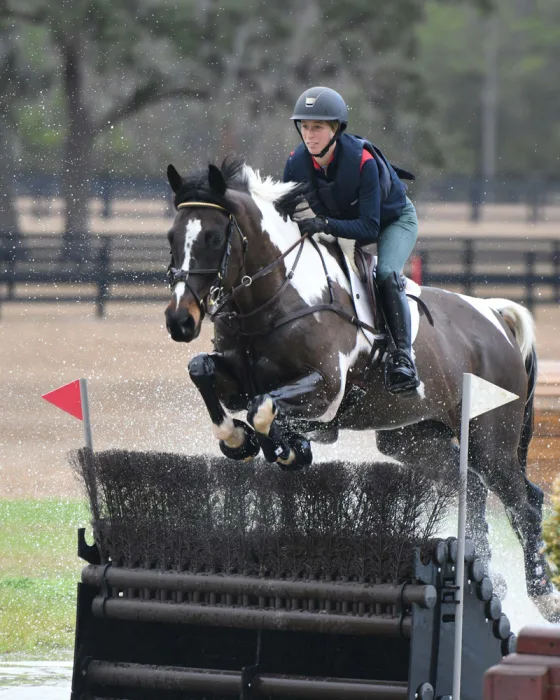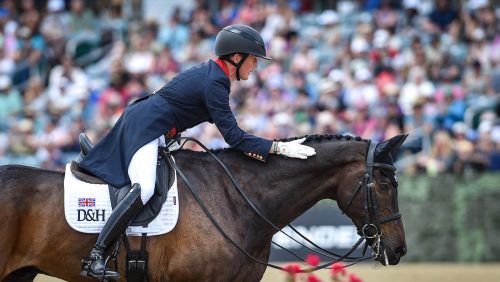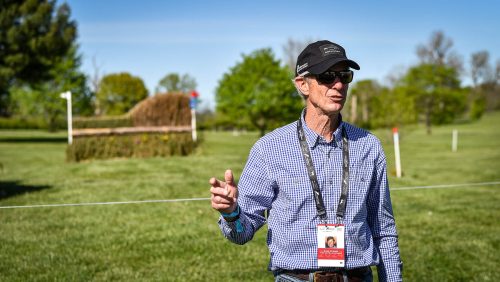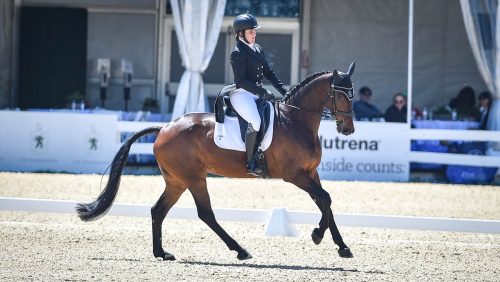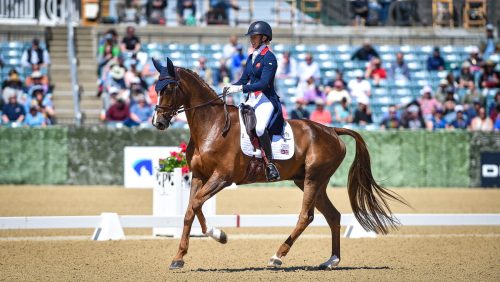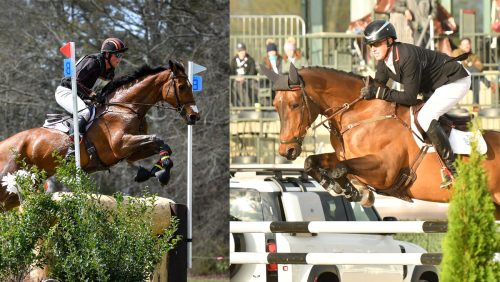After three days of intensive dressage and jumping work with USEF Eventing Emerging Athlete Coach Leslie Law, the 11 participants in the U.S. Equestrian Emerging Athlete Eventing 25 Program Training Session applied the principles they’d been practicing to the cross-country course at Horsepower Equestrian in Ocala, Florida, on Jan. 11.
The Importance Of Warm-Up
Law asked each group of horses and riders to warm up with long, sweeping, galloping lines over inviting fences. “Right from the get-go, think about what you’ve got between the jumps, especially your rhythm and balance,” he said. “If you have the right balance, it makes everything else so much easier.
“Your horse ideally needs to be settled as well, not wild and running through the bridle,” he continued. “You see race horses that come tearing out of the gate fighting the jockey, and they run their race in the first half and then fade away. It’s the same idea for our horses on cross-country. It’s intense these days, so the more settled they are from the start, the less tired they’ll ultimately be over those 10 minutes you’re on course.
“What are the fastest horses on cross-country? The ones that don’t pull. Forward, but not pulling,” Law added, explaining to the first group of riders that he felt all three of their horses were a little too strong in the bridle.
“It could be because it’s the beginning of the year and they’re fresh, but that’s also where training has to come in,” he said. “You have to work them between the jumps so that they’re forward and balanced. It’s not about being aggressive, but working them to be in more self-carriage as they gallop instead of being so up against the hand. Then in front of the jump you don’t have to do as much to set them up.
“If you have to do too much setting up before every fence, you’ll often end up being slow on time,” he concluded. “It’s better to be in a position to be pushing them up into the bridle than trying to wrestle them off it. But at the same time that doesn’t mean to say they’re not in front of your leg. They always have to be in front of your leg, just not fighting with you the entire way around.”
Balance, Balance And More Balance
Participants were next asked to ride a series of fences back and forth between a ditch, bank and skinny, each separated by just three strides. The sequence caused several horses and riders to come to grief, glancing off the skinny after jumping down a bank.
Clara Cargile rides the bank-ditch-skinny line on White Indian:
“Whether it’s this small bank or the Leaf Pit at Burghley, you have to come off of it in the right balance—they can’t come off it so big that they land in a heap,” Law explained to Chris Talley of Honey Brook, Pennsylvania, riding Hannah Salazar’s stunning 10-year-old Oldenburg stallion Sandro’s Star, who is being prepared for his first run at advanced this year.
“As you come off the bank, get your eye on the skinny and work his mouth a bit, so he’s not so much in the bridle,” Law said. “With more training you shouldn’t have to do so much, because when we use the hands too much to a skinny, they tend to not see it.
ADVERTISEMENT
“The exercise here is keeping your horse on the line wherever they go, especially up and down banks where they often jump off the line,” Law continued. “Coming off banks it’s very easy to look where we’re landing as opposed to where we’re going. But your eye has to be on the skinny because your horse may not see it right away, so it’s our job to have our eyes on it and tell the horse, ‘Get your eye on this too.’ ”
Will Zuchslag on Go Happy:
Trust Your Instincts
The next challenge for horses and riders was a bending sequence back and forth between four tables, where Law walked off the distance between the first two jumps as a straightforward six strides, and then five strides to the next table—but the bending line to the final obstacle walked right at 5½ strides. Now what?
“Again, this is what we’ve been talking about—getting them in the right balance. If they’re too much up in the bridle, this is going to be really tricky,” Law instructed. “What is the right number? It could be five or six. For me, the line is more important than the number.
“This is where our instincts have to kick in, depending on how things are going up to this point,” he continued. “If I was riding this, it really would be a heat of the moment decision for me, no matter how many times I’d walked it. I would react to what I was feeling from my horse. That’s why schooling these types of exercises is so important. You have to learn to react to what’s happening. The best advice I ever got was that you can walk the course and have a plan, but you have to be able to ride the moment. That’s the art of cross-country.
“You watch Phillip [Dutton] or Boyd [Martin], and you see Boyd ride a line in six that you walked in five, yet he’s a very forward rider. For whatever reason, he instinctually knew when he jumped in there that he needed one more, and that’s what splits the best from the rest,” Law added.
Tayler Stewart riding the tables on Ideal Contini:
Keep Them Straight
Moving on to a sprawling coffin combination, Law asked riders to canter two strides across the bottom on the first pass, but then on the second approach to come over a rolltop, bounce down the bank, and make one stride across to jump up the opposite bank and out.
“Here’s where you must keep your horses in front of the leg, but you also need very good upper body control to be able to hold with the body,” Law noted. “Lucinda Green always talks about the ‘coffin canter,’ which is that short, bouncy stride that’s more like a 10’ step as opposed to a 14’ or 16’ step, but it’s full of energy and impulsion. Remember, a collected canter is a still a forward canter, just with a shorter stride.”
West Coast representative and 2017 Adequan/FEI North American Junior and Young Rider Championships two-star team silver medalist Sophie Click of Snoqualmie, Washington, was excited to be attending her first Emerging Athlete clinic, but she also had her hands full containing the enthusiasm of her 10-year-old Irish gelding Fernhill Rising.
ADVERTISEMENT
“You’ve accomplished everything you have a little bit off your talent,” Law told Click. “But you can’t just rely on that—now looking to move up to the three-star level, his enthusiasm could eventually overrun his training. So this is where we have to do more homework. Remember, you want to be at the point where when schooling cross-country that you can have a conversation with your horse, not an argument.”
When the gelding became crooked in the neck as he resisted his rider’s requests, Law gave Click some new strategies that produced promising results on her next pass through the combination. “You can’t be pulling right, and he’s going left,” Law said. “You have to be able to go at whatever speed you want, with the right feel, and his neck and shoulders straight. If he gets crooked, try using bridged reins to help keep his shoulders straight to the fence. A lot of race horses are galloped with bridged reins because it works to help keep them straight too.
“Horses are what they are, and they have certain tendencies that you’re probably never going to completely change,” he added. “But you can learn to manage them and make them better.”
Getting Your Head In The Game
Working in the water complex, Cornelia Dorr of Manchester-By-The-Sea, Massachusetts, asked Law about her mount’s tendency to pull her forward when jumping down into water. “Try a little more release dropping into the water, and you can even try taking a hand off the reins like Andrew Nicholson,” Law suggested. “But you can’t just do it once in a while—you have to practice it over and over so that you’re confident doing it when you need it in competition.”
As a conclusion to the day’s work, Law asked each rider to apply their dressage work in navigating a difficult one-stride combination of offset brushes before galloping on to two large corners. “Make him rounder. Make him rounder. Rounder. Make him rounder,” Law repeated over and over as each pair approached the first jump. “This is where the connection that we’ve been working on all week comes into play. Think about that super-connected canter coming into a question like this. It’s not about having their heads too high or putting their heads down. It’s about putting it where you need it. That is what your warm-up is for—to make sure their head is in the right place.”
Building The Future
Savannah “Woodge” Fulton of Finksburg, Maryland, completed the Rolex Kentucky CCI**** and the Land Rover Burghley CCI**** (England), but in the day’s second group of horses and riders she rode a young prospect: Nelson Warnell’s 5-year-old Thoroughbred-Dutch Warmblood cross Midnight Illusion. Fulton said the gelding has just started his career with beginner novice and novice outings and will move up to training this year.
The youngster had no problem tackling the day’s new experiences including a large ditch and his first skinny, as Law spoke about how he likes to develop rising stars. “With a young, looky horse, it can be a temptation to be a little aggressive, but you never want to scare him. Instead, create positive learning opportunities,” Law explained. “For instance, coming down to a fence when I have the rhythm and balance I want and see my distance, maybe six strides out I sit a little quiet and see what they do with it. Do they move up? Do they back off? I create the situation and give them the responsibility.
“You can’t just sit there and do absolutely nothing, nor can you overthink it and try to manage everything and end up doing too much,” he continued. “Especially with the young horses, that’s how they learn. I don’t lie to them, I just hand them the situation and see how they respond. If they make a little mistake, I let them understand what happened and grow from it. That’s how we build their confidence for the future.”
Additional Words Of Wisdom From Law:
- “Remember you have to push the horse forward, but not so much that they don’t have time to mentally process everything.”
- “You can’t try to fix everything, and you don’t want to have to be doing too much manhandling in the last two strides to a jump. By then it’s too late.”
- “Close the hand and remember that lightness actually comes from the release of the hand.”
- “It’s always easier to practice something when the fences are easier, so use smaller jumps to work on what you need to improve. The jump doesn’t have to be big to get something valuable out of it.”
- “As you’re galloping along, you should always be asking yourself, ‘Are we in balance?’ If the horse is running through the bridle, you’re not in balance. If the horse isn’t in the bridle and is behind the leg, you’re also not in balance. So think of it like a set of scales—you always want them balanced on both sides, so they just stay in the middle. That is our responsibility to make sure the horse is in balance coming up to the fence, but then it’s their responsibility to actually jump it.”
- “The time to focus on this type of training is during your conditioning days. Conditioning days shouldn’t be just about trotting and cantering around mindlessly on a slack rein. Use the time as an opportunity to teach the horse the right way to carry himself as you will want him to on the cross-country course: in the bridle, not against it. So make those days matter.”
Read all about Day 1 in “Leslie Law Wants Riders To Be Brave In Dressage” and Day 2 in “Riders Learn What It Takes To Be Better.”




